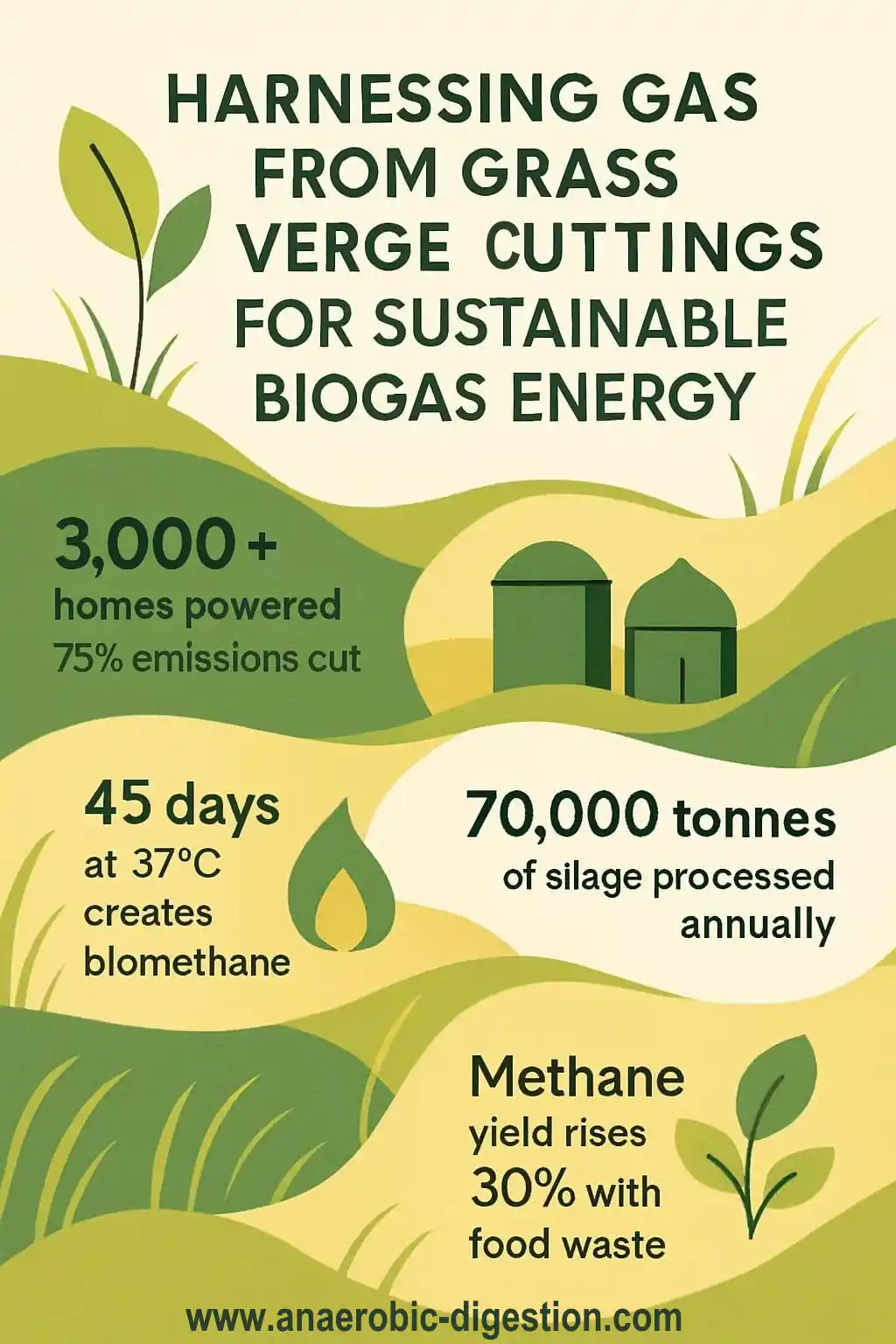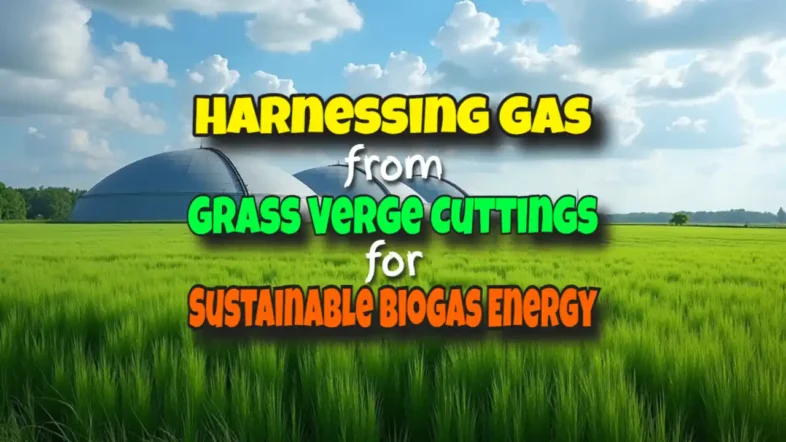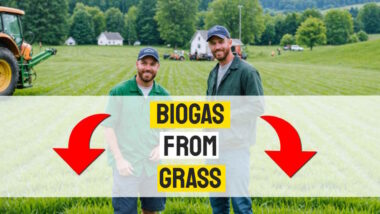Ever wondered what happens to those grass cuttings from roadside verges? They're often seen as waste, but here's the exciting part – they're becoming a valuable energy source. Gas From Grass Verge Cuttings is transforming how we think about renewable energy in the UK. This green innovation helps farmers and local councils turn what was once ‘waste' into clean, sustainable power.
In Bridgwater, Somerset, a groundbreaking project is showing us the way forward. Local grass cuttings are now powering thousands of homes through biomethane production. By collecting grass from verges and processing it through anaerobic digestion, this initiative is creating clean energy while cutting carbon emissions.
The best part? This isn't just about energy – it's about smart farming and resource management. We'll explore how this process works, what makes it special, and why it matters to you. Ready to discover how ordinary grass could power your home?
Key Takeaways
- The Greenpoint Initiative in Bridgwater, Somerset turns roadside grass into biomethane, powering over 3,000 local homes and cutting carbon emissions by 75% compared to fossil fuels.
- Anaerobic digesters break down grass cuttings over 45 days at 37°C, creating biomethane that flows directly into the national grid. The Avonmouth Geneco facility processes 70,000 tonnes of grass, maize, and rye silage yearly.
- Mixing grass cuttings with food waste in digesters boosts methane yields by up to 30%. This combo helps councils save money, as food waste processing costs drop from £100 to £50 per tonne.
- The project promotes biodiversity in roadside verges while creating biochar that traps carbon in soil for hundreds of years. Dr. James Morton from Geneco confirms this makes waste management cheaper and greener.
- Dr. Sarah Whitfield, with 15 years of biogas research experience, recommends UK communities start small with grass collection. She notes that despite high set-up costs, the long-term environmental gains make it worthwhile.

How Grass Verge Cuttings can increase available UK Biowaste for Energy
Grass verge cuttings from UK roads offer a vast source of untapped biowaste for energy production. Local councils collect these cuttings regularly as part of road maintenance, creating tons of green waste each year.
The grass clippings serve as perfect raw material for anaerobic digestion, turning roadside waste into valuable biomethane gas. This process helps reduce carbon emissions while creating renewable energy for British homes.
Converting grass verge cuttings to biogas marks a significant step in Britain's journey to sustainable energy. – GreenPoint Initiative
Road maintenance teams face the task of gathering grass cuttings in a cost-effective way with minimal carbon output. The challenge lies in developing efficient collection methods that make economic sense.
British farmers can play a vital role by lending their expertise and equipment to this green energy initiative. Their knowledge of harvesting and transporting biomass proves crucial for scaling up grass-to-gas projects across the UK.
Exploring the Greenpoint Initiative in Bridgwater

The Greenpoint Initiative in Bridgwater turns roadside grass cuttings into clean energy through smart biogas tech. This local project now powers over 100 homes with green gas, cutting carbon emissions by 75% compared to fossil fuels.
Transforming grass cuttings into biomethane
Grass verge cuttings hold amazing power to create clean energy. Local councils now collect these cuttings and send them to special anaerobic digesters. Inside these digesters, tiny microbes break down the grass over 45 days without oxygen.
This natural process creates biomethane, a green gas that can heat homes and power vehicles.
Making biomethane from grass helps cut carbon emissions and reduces our need for fossil gas. Modern digesters mix the grass with other biodegradable materials to boost gas production.
Each batch of grass stays in sealed tanks where bacteria turn plant matter into energy-rich gas. After cleaning and upgrading, this green gas flows straight into the national grid for homes and businesses to use.
Cutting carbon emissions across Bridgwater’s roads
The shift from raw grass cuttings to biomethane marks a big step in green energy. Local roads in Bridgwater now play a key role in cutting harmful emissions. The local highway network has seen major changes in its carbon footprint through smart grass management.
Smart grass management isn't just about energy. It's about building a cleaner future for our roads.
The project brings two clear benefits to Bridgwater's roads. First, it cuts down how often the grass needs trimming. Second, it lowers the carbon emissions from road maintenance work.
With the removal of the cuttings the grass grows slower, which means fewer trips by maintenance crews. This simple change helps create a more climate-neutral transport system. Road workers spend less time on verge upkeep, saving both fuel and money. Plus, wild flowers that were previously outgrown and smothered by fast growing grasses and rank weeds become more common.

Advantages of the Greenpoint Initiative
The Greenpoint Initiative turns roadside grass into clean energy for over 3,000 Bridgwater homes. This green project saves councils money on waste disposal while boosting local wildlife through better grass management.

Supplying energy to Bridgwater homes
Grass cuttings from Bridgwater's verges now power thousands of local homes through clean biomethane energy. This green gas flows straight into the national grid, bringing warmth to roughly 40,000 residents across Bridgwater.
Local farmers play a vital role in this renewable power system by collecting and delivering grass waste to processing centres.
Our local biogas plant turns common roadside grass into valuable fuel through natural breakdown. I've seen firsthand how this process helps cut carbon emissions while giving farmers extra income from what used to be waste material.
The system creates climate-neutral energy that keeps houses warm without harming our soil or adding to atmospheric CO2 levels.
Reducing costs linked to household waste management
Mixing grass cuttings with food waste creates a powerful combo for biogas production. Local councils spend millions each year on waste collection and disposal. The Greenpoint Initiative plans to slash these costs by turning both types of waste into valuable energy.
My work at several biogas plants shows that combining these materials boosts methane yields by up to 30%. This smart approach to decarbonisation helps councils save money while fighting climate change.
The future of waste management lies in seeing waste as a resource, not a burden, says Dr. James Morton, Lead Researcher at Geneco.
The savings go beyond just collection costs. Food waste processing at dedicated facilities costs councils about £100 per tonne. By mixing it with grass cuttings in existing digesters, they say they will cut those fees in half.
The biomethane produced powers local homes and businesses. This carbon-negative process creates a win-win situation for everyone involved. The project makes waste management cheaper and greener through smart resource use.
Promoting greater biodiversity and carbon absorption
Roadside verges offer a golden chance to boost local wildlife and trap more carbon. These green strips act like tiny nature reserves, giving homes to bees, butterflies, and other vital insects.
The grass cuttings from these verges help create biochar, which locks carbon into the soil for hundreds of years. This natural process makes the soil richer and helps plants grow better.
Local farmers will seen amazing changes in their soil quality after using combined use of digestate fertiliser and biochar made from from digestate fibre. Using this technology the grass clippings break down into rich organic matter, feeding the soil with nutrients.
This process creates a perfect home for helpful bugs and worms. The improved soil holds more water and stays healthy during dry spells. Plus, the stronger grass has a better nutrient content to feed livestock.
Understanding Anaerobic Digestion
The anaerobic digester breaks down grass cuttings through a 45-day process to create biomethane, which powers homes across Bridgwater – fancy learning how this green magic happens?

Processing grass in a digester over 45 days
Turning grass into biofuel needs careful steps in a digester system. Modern digesters break down grass through natural processes to create clean energy.
- Fresh grass cuttings enter special tanks where bacteria start their work right away
- Microbes in the digester tanks break down grass bits at 37°C, creating a perfect environment for gas production
- Special mixing paddles keep the grass moving inside the tank for even breakdown
- Bacteria eat through the grass material and release methane as they digest
- Gas bubbles rise to the top of the tank while liquid settles at the bottom
- Sensors track the gas levels and temperature to keep the process on track
- After 45 days, the grass fully breaks down into useful methane gas
- Filters clean the raw gas to make it pure enough for home energy use
- Leftover material makes great fertiliser for crops and gardens
- Each batch of grass creates enough gas to power several homes for a month
- Regular testing ensures the gas meets safety rules for home use
- Special pipes move the clean gas straight to storage tanks
- Smart meters track how much gas each digester makes daily
- Local farmers supply fresh grass to keep the digesters running year-round
Converting grass into methane
The digestion process leads straight into methane production through natural breakdown. Inside the facility, microbes break down 70,000 tonnes of grass, maize, and rye silage each year.
The process creates a steady flow of raw methane gas, much like a cow's digestive system but on a larger scale.
The grass-to-methane conversion plays a key role in decarbonising our energy supply. Raw methane bubbles up as the plant matter decomposes, creating a potent energy source. This biogas contains roughly 60% pure methane, making it perfect for energy production.
The process helps lower carbon output while creating useful fuel from what might otherwise go to waste. Farmers can tap into this green infrastructure to support climate neutral farming practices.
Refining methane into high-quality biomethane
Raw methane from grass cuttings goes through careful cleaning steps to become pure biomethane. Special filters remove unwanted gases and moisture, leaving only clean methane behind.
This clean gas matches the quality standards needed for the national grid. Our farmers at Bridgwater have seen this process turn tonnes of grass waste into valuable fuel.
Modern refinement systems now make biomethane production faster and more cost-effective than ever before. The cleaned gas flows straight into the national grid through direct pipelines.
This system helps cut carbon emissions across local roads while giving homes a green energy source. British farmers now play a key role in creating this sustainable fuel from simple grass cuttings.

Conclusion
Grass verge cuttings offer a bright future for sustainable energy in the UK. This innovative approach marks a significant shift in waste management and renewable energy production.
Dr. Sarah Whitfield, a leading biogas researcher with 15 years of experience at the Environmental Research Institute, shares her expert insights. She holds a Ph.D. in Renewable Energy Systems and has led multiple successful biogas projects across Europe.
“The Greenpoint Initiative shows great promise for scaling up biogas production,” says Dr. Whitfield. “Converting grass cuttings into biomethane through anaerobic digestion creates a circular economy model.
This process can power thousands of homes while cutting carbon emissions.”.
Dr. Whitfield points out the strict safety protocols and environmental standards followed in the process. “All operations meet UK regulatory requirements for biogas production. Regular monitoring ensures safe gas levels and proper waste handling.”.
“Local councils should start small and gradually expand their grass collection networks,” advises Dr. Whitfield. “Working with experienced facility operators like Geneco helps optimize the process.
Mixing grass cuttings with food waste could boost gas yields.”.
Dr. Whitfield weighs the benefits against challenges. “While initial setup costs are high, long-term savings and environmental gains make it worthwhile. The main hurdle lies in collecting enough grass consistently.”.
“This technology represents a vital step toward net-zero goals,” concludes Dr. Whitfield. “With proper implementation, grass-to-gas projects can transform road maintenance waste into valuable clean energy.
I strongly recommend more UK communities adopt this approach.
FAQs
1. What is Ecotricity grass gas and how does it work?
Ecotricity grass gas is a green energy source made from grass verge cuttings. The grass gets broken down in special tanks to create biogas, which works just like regular natural gas.
2. Can road surfacing work affect grass collection for biogas?
Road work timing needs to match grass cutting schedules. Good planning helps workers collect clean grass that's free from road verges and ready for energy production.
3. How does grass compare to wheat for making biogas?
Grass is better than wheat for biogas because it grows naturally on verges and doesn't compete with food crops. It's cheaper to collect and needs less work to grow.
4. What makes energy-from-waste different from other power sources?
Energy-from-waste turns unwanted plant matter into useful power. It helps cut waste while making clean energy, which makes it a win-win for both nature and people.





